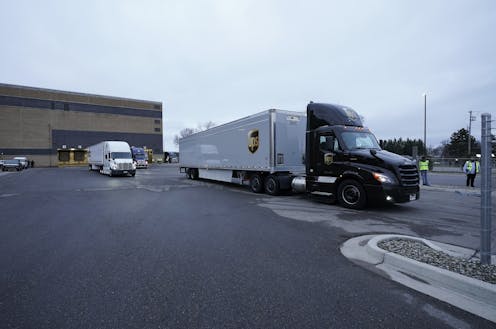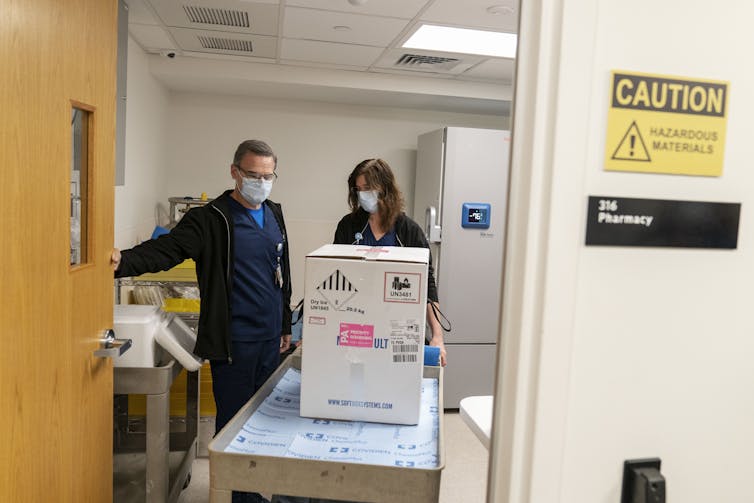What vaccine distribution planners can learn from Amazon and Walmart
COVID-19 vaccines have very specific storage requirements that make shipping a difficult task. Two ideas – fulfillment centers and cross-docking – could help overcome some distribution challenges.

The initial rollout of Pfizer’s COVID-19 vaccine has begun, and vaccines are shipping across the U.S. Demand for COVID-19 vaccines will outpace supply for the foreseeable future. Yet experts have warned that a substantial proportion of these highly perishable vaccines could go to waste if they are not being used before they expire.
With such short supplies and high demand, worrying about waste may sound paradoxical, but is actually a predictable result of two well-known medical distribution challenges: complicated storage requirements and variability in demand.
We are two supply-chain experts who have studied vaccine purchasing and distribution. Drawing from our decadeslong research into supply-chain management and health care operations, we believe two supply-chain ideas practiced by Amazon and Walmart can help reduce waste and minimize shortages of COVID-19 vaccines.

Fulfillment centers solve demand variability
For a given county, it is reasonable to expect demand for COVID-19 vaccines to be relatively stable. But forecasting demand at individual vaccination sites within a county on a weekly or daily basis is going to be challenging. People might miss or skip appointments for a variety of reasons, and few hospitals have the ability to share real-time usage and inventory information with public health authorities. Any time there is a mismatch between supply and demand, there is waste: Doses could spoil if they were already defrosted, or be sitting unused in freezers at one hospital while another hospital nearby is running short.
Fast fulfillment of uncertain demand is not unique to vaccine distribution. Amazon faces highly volatile demand for millions of products and yet is able to offer same-day and one-day delivery to 72% of the U.S. population. Its secret lies in regional fulfillment centers that pool inventory to meet demand across large regions.
Instead of shipping vaccines directly to hospitals and pharmacies, states could set up regional “fulfillment centers” in different counties with pooled inventory – much like Amazon’s. These fulfillment centers can restock vaccination sites on demand on a daily or weekly basis as needed. By using this just-in-time distribution strategy, supply could better match demand at specific sites and reduce potential waste of vaccines.

Getting vaccines to where they are needed
Regional fulfillment centers can help alleviate waste from fluctuating demand at different local sites, but you still need to be able to get vaccines to fulfillment centers. The faster this happens – and the less storage needed along the way – the less possibility for wasting vaccines.
Pfizer’s vaccine has to be kept at minus 70 degrees Celsius (minus 94 degrees Fahrenheit) for long-term storage. This requires expensive, ultralow-temperature freezers that have quickly become scarce as countries and states race to build their vaccine logistics infrastructure. Moderna’s vaccine requires only regular freezers, but some rural areas in the U.S. and many developing countries lack cold-chain infrastructure.
One way to minimize storage needs is to use an approach called cross-docking. Walmart, sometimes called “the king of cross-docking,” popularized this idea that all but does away with excess storage requirements.
Instead of taking deliveries from incoming trucks to intermediate national or state-level warehouses, and then from warehouses to outgoing trucks, cross-docking skips the storage step. You can simply move goods across a loading dock directly from the trucks that came from airports or vaccine manufacturers straight to the outgoing trucks that are headed to various regional fulfillment centers.
Applying the cross-docking idea to vaccine distribution would greatly reduce the need for cold storage by getting rid of the need for freezers at intermediate warehouses. This would be especially beneficial to rural areas and developing countries.
To be certain, cross-docking requires meticulous planning and coordination from vaccine manufacturers, distributors, health departments, ground transportation companies, health care providers and patients, but it is doable. Walmart has built one of the most efficient supply chains on earth using this very idea.
A smooth chain from manufacturer to hospital
U.S. health authorities could set up a system that uses cross-docking and freezer trucks to first deliver the vaccines from airports or manufacturers to multiple regional fulfillment centers while minimizing the need for intermediary storage. Pfizer’s vaccine is shipped in packages containing a minimum of 975 doses. Once taken out of the the freezer and put in a refrigerator, each vaccine can last no more than five days. But not every vaccination site, especially in rural areas, can give 975 doses within five days. At the fulfillment centers, the vaccines would be split up into smaller packages and moved into vehicles that distribute these defrosted doses in small batches to local vaccination sites for just-in-time immediate use.
[Deep knowledge, daily. Sign up for The Conversation’s newsletter.]
Large retailers like Amazon and Walmart have developed time-tested supply-chain tools that public health authorities could learn from. Designing effective COVID-19 vaccine supply chains could help vaccinate the population efficiently and smoothly with less waste.
The authors do not work for, consult, own shares in or receive funding from any company or organization that would benefit from this article, and have disclosed no relevant affiliations beyond their academic appointment.
Read These Next
West Antarctica’s history of rapid melting foretells sudden shifts in continent’s ‘catastrophic’ geo
A picture of what West Antarctica looked like when its ice sheet melted in the past can offer insight…
How to reduce gift-giving stress with your kids – a child psychologist’s tips for making magic and a
Depending on family circumstances and a child’s personality type, gift giving runs the gamut of fun…
The world risks forgetting one of humanity’s greatest triumphs as polio nears global eradication − 7
Polio may finally be defeated in the next 5 years. Will the world recognize what an extraordinary achievement…






